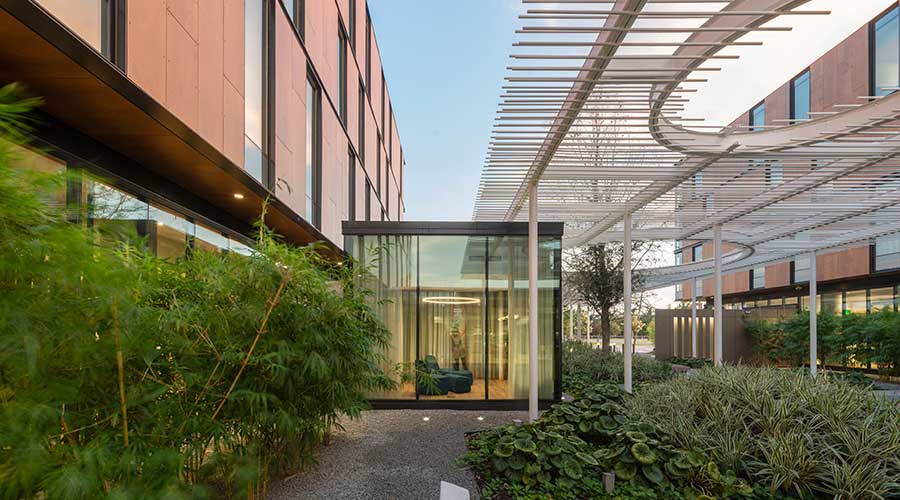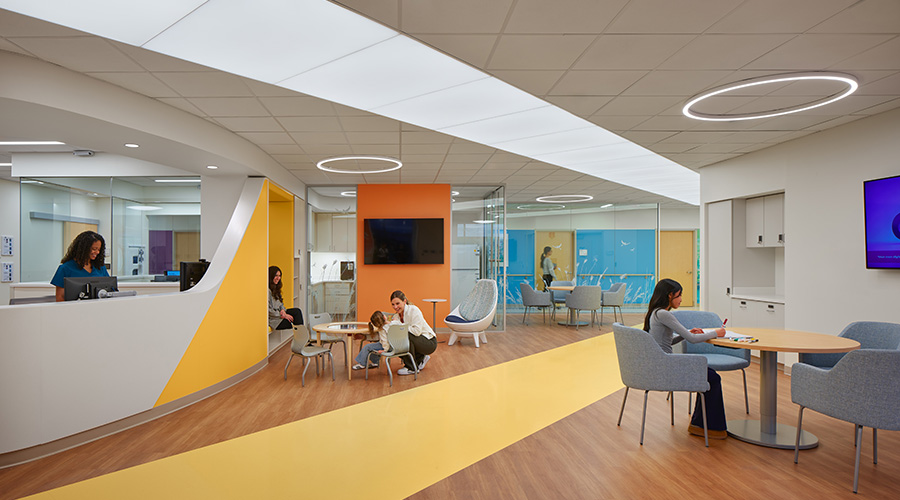Healthcare facilities managers face pressures to reduce costs without affecting quality of care. In the long list of patient-care needs, they might view a garden as nice to have but not essential.
In fact, “there’s plenty of research to support the relationship between health and nature,” says Tori Wickard, senior project architect and associate in the Dallas studio of Perkins & Will.
A 1984 study in the journal Science was the first to definitively link nature to measurable health outcomes. The researchers found that patients with bedside windows who looked at trees healed on average one day faster, needed less pain medication and had fewer postsurgical complications than patients who instead saw a brick wall.
Subsequent studies have found that looking at or being near trees, flowers and water can reduce anger, anxiety and pain, induce relaxation, improve memory and contribute to better outcomes for myriad health complications, including dementia, depression and stroke.
These health benefits are obviously important for patients, but they are not the only beneficiaries. Research has also found that integrating nature into buildings lowers workers’ stress levels and increases their job satisfaction, which might explain the reason one study found that hospital employees accounted for as many visits to hospital gardens as patients.
Mounting scientific evidence along with the popularity of the WELL Building Standard is encouraging more healthcare facilities managers to invest in outdoor healing spaces, often called Zen or peace gardens.
Unfortunately, it is not enough to plant a few trees. Research has also shown that not all gardens are equally effective.
The greatest benefits come from mature trees bordering water features and flowering plants. More greenery than hard surfaces is also important. People also prefer private conversation areas, smooth paths that are safe for wheelchairs, lightweight furniture that can be moved to sun or shade and natural habitats that attract native wildlife.Wickard says other key elements include sensory experiences — dabbled light, reflections, billowing materials, etc. — thermal and airflow variability — changing the temperature and wind speed using plantings or water features— and dynamic or diffuse light.
Landscape architects can ensure that the outdoor space adheres to best design practices, as well as making sure it addresses the unique needs of the facility’s staff and guests.
When Wickard’s team recently installed a healing garden at the Hope Lodge at the American Cancer Society in Houston, they took time to truly understand the community’s needs. They made the garden a central feature so visitors in most rooms could benefit from its healing properties. They included spaces for dining, socializing and contemplation. They also knew that a water feature was out of the question due to immunocompromised patients, so they commissioned an art piece that exuded water-like qualities.
An architect will also consider the way factors such as bird-migration and weather patterns affect plantings and wildlife, and ensure that maintenance costs are as low as possible by choosing native or adaptive plants that require less irrigation and care.
“A garden isn’t just plantings,” Wickard says. “A landscape architect is really critical to implementing a healing garden. They consider all of the elements.
“The most critical piece of the puzzle is finding a landscape architect whose work resonates with you. They are critical to making sure the healing garden completes the architecture and vice versa. They consider all of the elements because a garden is so much more than just plantings.”
Becky Mollenkamp is a freelance writer based in St. Louis.

 Contaminants Under Foot: A Closer Look at Patient Room Floors
Contaminants Under Foot: A Closer Look at Patient Room Floors Power Outages Largely Driven by Extreme Weather Events
Power Outages Largely Driven by Extreme Weather Events Nemours Children's Health Opens New Moseley Foundation Institute Hospital
Nemours Children's Health Opens New Moseley Foundation Institute Hospital Code Compliance Isn't Enough for Healthcare Resilience
Code Compliance Isn't Enough for Healthcare Resilience Ribbon Cutting Marks First Phase Completion for New Montefiore Einstein Facility
Ribbon Cutting Marks First Phase Completion for New Montefiore Einstein Facility